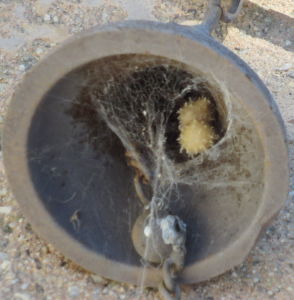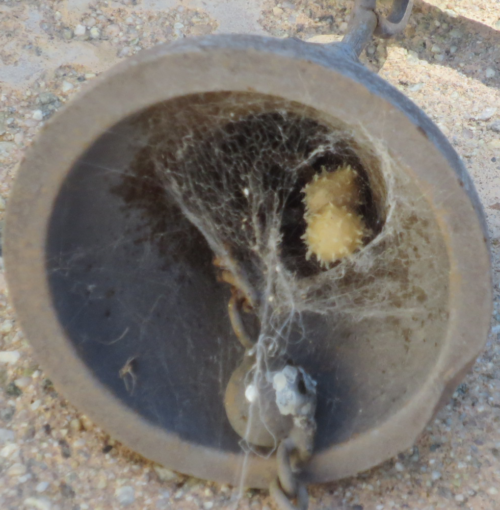Certain spider webs appear to have been spun by an arachnid with a talent for asymmetrical design. One spider that creates what might look like a web without a balanced plan is the Black Widow Latrodectus hesperus. I have seen a couple of these spiders in my yard after dark, suspended motionless from a web created using my cats’ outdoor run to anchor the main filaments, what we might think of as the support beams, for their webs. At dawn, this spider takes cover in cracks, crevices, hollow spaces in patio furniture, any dark place that serves well as a good hiding place. It will return to the web at dusk.
Last summer, a pest-control professional confirmed that my identification of a black widow on our cats’ outdoor run was correct. I consulted him because of the spider’s presence: were we going to be overrun by them? I am a recent transplant from the East coast; this was my first sighting of a black widow. Was the next stop our kitchen? The answer was “No!”. He taught me how to identify the widow spider’s web and advised me to clear the webs away regularly, indoors and out, but discouraged the use of pesticide. Pesticide is a blunt instrument, a clumsy generalist that can kill everything in the garden. I was relieved to hear his recommendations.
The widow’s web (both black and brown, more on the brown widow below), is a fairly large, perhaps triangular, three dimensional structure; other than that, it looks like a mess of threads. I do not go out of my way to find widow webs; if one is living in some spot where my husband and I or our two cats never go, then I probably do not know it exists, thus oblivious, I leave it to its dark, quiet recess (which is what it prefers). When I find a web in an area we frequent, I destroy the web during the day when the widow is not active. If she is still around, she will rebuild her nest that night. This cycle continues for some days, but it is not sustainable on her part. It takes a great deal of energy to build a web. She either moves on to another build location or succumbs to a predator. (I do not know what dares to prey on this spider.)

This summer a small bell that is part of a garden fixture in our yard has acquired a mat of webbing around the opening and clapper. Some long support filaments attach from the bell to points below. A Brown Widow Latrodectus geometricus has taken up residence inside. She is not visible in the photo because she is hiding in a shadow behind a couple of egg sacs, but her eggs provide a positive identification. The brown widow egg sac has “spikes” protruding from the surface, the black widow egg sac is smooth.
The brown widow is not native to California. Experts are unsure of the species’ native origin, Africa or South America are both possibilities. From Florida, where it first established itself in North America, the brown widow eventually crossed the country, probably with lots inadvertent help from us, arriving in Southern California about 10-15 years ago. The brown widow’s bite is said to be much less venomous than that of the black widow.
Any small, undisturbed recess located in venomous spider territory is best approached with caution. Pesticide-free gardens are full of spiders most of them are not only harmless to us but helpful, as they help maintain an insect critter balance. When I found a non-venomous spider living inside a miniature teapot wind chime that I had intended to clean and move from one location to another, I moved the chime but deferred cleaning to some later date. Somebody was living in there!

